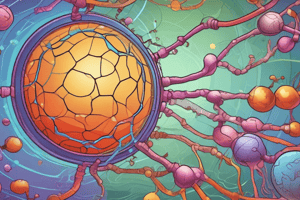Podcast
Questions and Answers
What is the primary function of cellular metabolism?
What is the primary function of cellular metabolism?
- Producing chemical energy like ATP (correct)
- Breaking down cell components for recycling
- Maintaining cell membrane integrity
- Regulating cell growth and division
Which process involves synthesizing glucose and organic compounds from atmospheric CO2?
Which process involves synthesizing glucose and organic compounds from atmospheric CO2?
- Photosynthesis (correct)
- Cellular respiration
- Krebs cycle
- Glycolysis
What is the role of autotrophs in obtaining matter and energy?
What is the role of autotrophs in obtaining matter and energy?
- They synthesize organic compounds from atmospheric CO2 (correct)
- They store excess energy in the form of ATP
- They break down organic molecules to release energy
- They obtain nutrients by consuming other organisms
What is the function of heterotrophs in obtaining matter and energy?
What is the function of heterotrophs in obtaining matter and energy?
Which term refers to the process of converting nutrient molecules into molecules of the cell?
Which term refers to the process of converting nutrient molecules into molecules of the cell?
What is the main function of ATP in cellular metabolism?
What is the main function of ATP in cellular metabolism?
What is the main source of energy for photoautotrophs?
What is the main source of energy for photoautotrophs?
Which type of organisms can use organic compounds as a source of energy and carbon?
Which type of organisms can use organic compounds as a source of energy and carbon?
What is the function of ATP in cellular metabolism?
What is the function of ATP in cellular metabolism?
Which process involves the formation of new covalent bonds and requires an input of chemical energy?
Which process involves the formation of new covalent bonds and requires an input of chemical energy?
What is the main purpose of catabolism in cellular metabolism?
What is the main purpose of catabolism in cellular metabolism?
What are the metabolic intermediaries involved in cellular respiration?
What are the metabolic intermediaries involved in cellular respiration?
Where do heterotrophic cells acquire free energy from?
Where do heterotrophic cells acquire free energy from?
In which type of reaction does the system change to possess less free energy?
In which type of reaction does the system change to possess less free energy?
What is the net intake in anabolism?
What is the net intake in anabolism?
What is the function of reducing power carriers like NADH and NADPH in cellular metabolism?
What is the function of reducing power carriers like NADH and NADPH in cellular metabolism?
What is the primary function of cellular metabolism?
What is the primary function of cellular metabolism?
What is the main function of the metabolic pathway?
What is the main function of the metabolic pathway?
What is the part of metabolism responsible for the transformation of complex organic molecules or biomolecules into simpler molecules?
What is the part of metabolism responsible for the transformation of complex organic molecules or biomolecules into simpler molecules?
What is the process in which ATP is synthesized in a cyclic reaction?
What is the process in which ATP is synthesized in a cyclic reaction?
What do the letters 'NADH' stand for in the context of energy generation?
What do the letters 'NADH' stand for in the context of energy generation?
Which type of muscle fibers obtain ATP through aerobic and anaerobic metabolism?
Which type of muscle fibers obtain ATP through aerobic and anaerobic metabolism?
What does the process of oxidative metabolism include?
What does the process of oxidative metabolism include?
Which process involves the reduction of pyruvate to lactate when tissues have insufficient aerobic conditions?
Which process involves the reduction of pyruvate to lactate when tissues have insufficient aerobic conditions?
What is the main catabolic pathway that requires oxygen and can use lipids, proteins, and carbohydrates?
What is the main catabolic pathway that requires oxygen and can use lipids, proteins, and carbohydrates?
Which molecule contains phosphoanhydride bonds containing high chemical energy?
Which molecule contains phosphoanhydride bonds containing high chemical energy?
What is the type of reactions that transfer electrons between reactants called?
What is the type of reactions that transfer electrons between reactants called?
Flashcards are hidden until you start studying
Study Notes
Cellular Metabolism Overview
- Primary function is to manage energy and material transformations necessary for life.
- Metabolism includes pathways that break down and synthesize biomolecules.
Glucose Synthesis
- Photosynthesis involves synthesizing glucose and organic compounds from atmospheric CO2.
Role of Autotrophs
- Autotrophs obtain matter and energy by converting inorganic substances into organic matter, primarily through photosynthesis.
Role of Heterotrophs
- Heterotrophs rely on organic compounds for energy and carbon, consuming other organisms or organic materials.
Nutrient Conversion
- Anabolism refers to the process of converting nutrient molecules into cellular components and structures.
ATP Function
- ATP's main function is to serve as the energy currency for cellular processes and metabolism.
Energy Source for Photoautotrophs
- Light energy from the sun is the main source of energy for photoautotrophs.
Organic Compound Utilization
- Chemoorganotrophs utilize organic compounds as both energy and carbon sources.
Covalent Bond Formation
- Biosynthesis involves new covalent bond formation, requiring energy input.
Purpose of Catabolism
- Catabolism breaks down complex molecules into simpler ones to release energy.
Metabolic Intermediaries
- Key intermediaries in cellular respiration include Acetyl-CoA, pyruvate, and various citric acid cycle intermediates.
Free Energy Source for Heterotrophs
- Heterotrophic cells acquire free energy by breaking down organic matter.
Energy Changes in Reactions
- Exergonic reactions result in a system that has less free energy and are typically spontaneous.
Anabolism’s Net Intake
- Anabolism has a net intake of energy as it builds larger molecules from smaller ones.
Reducing Power Carriers
- NADH and NADPH function as reducing agents, donating electrons during metabolic reactions.
Metabolic Pathways Function
- The main function of metabolic pathways is to facilitate and regulate diverse biochemical reactions in metabolism.
Metabolic Breakdown
- Catabolism transforms complex biomolecules into simpler molecules for energy release.
ATP Synthesis
- Substrate-level phosphorylation is a process in which ATP is synthesized in cyclic reactions, often during glycolysis.
NADH Meaning
- NADH stands for Nicotinamide Adenine Dinucleotide (Hydrogen), serving as an electron carrier in metabolic reactions.
Muscle Fiber Metabolism
- Fast-twitch muscle fibers utilize both aerobic and anaerobic metabolism for ATP production.
Oxidative Metabolism
- Oxidative metabolism includes the use of oxygen to generate energy through the electron transport chain.
Pyruvate Reduction
- When oxygen is scarce, pyruvate is reduced to lactate in a process called lactic acid fermentation.
Catabolic Pathway with Oxygen
- The primary catabolic pathway requiring oxygen is aerobic respiration, which can metabolize lipids, proteins, and carbohydrates.
High-Energy Molecule
- ATP contains phosphoanhydride bonds, which store and release high energy for cellular functions.
Electron Transfer Reactions
- Redox reactions refer to the processes of transferring electrons between reactants, critical for metabolic pathways.
Studying That Suits You
Use AI to generate personalized quizzes and flashcards to suit your learning preferences.




